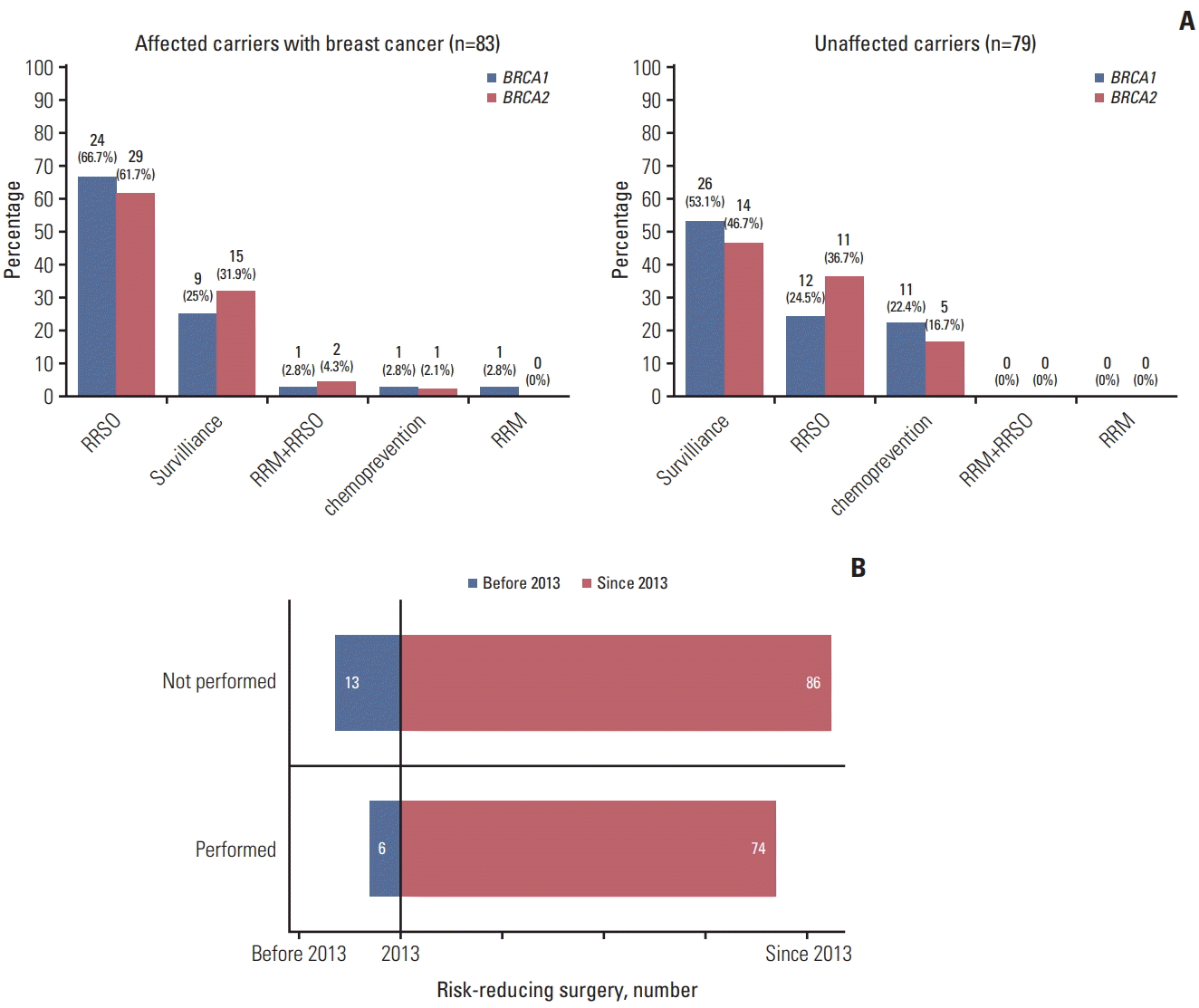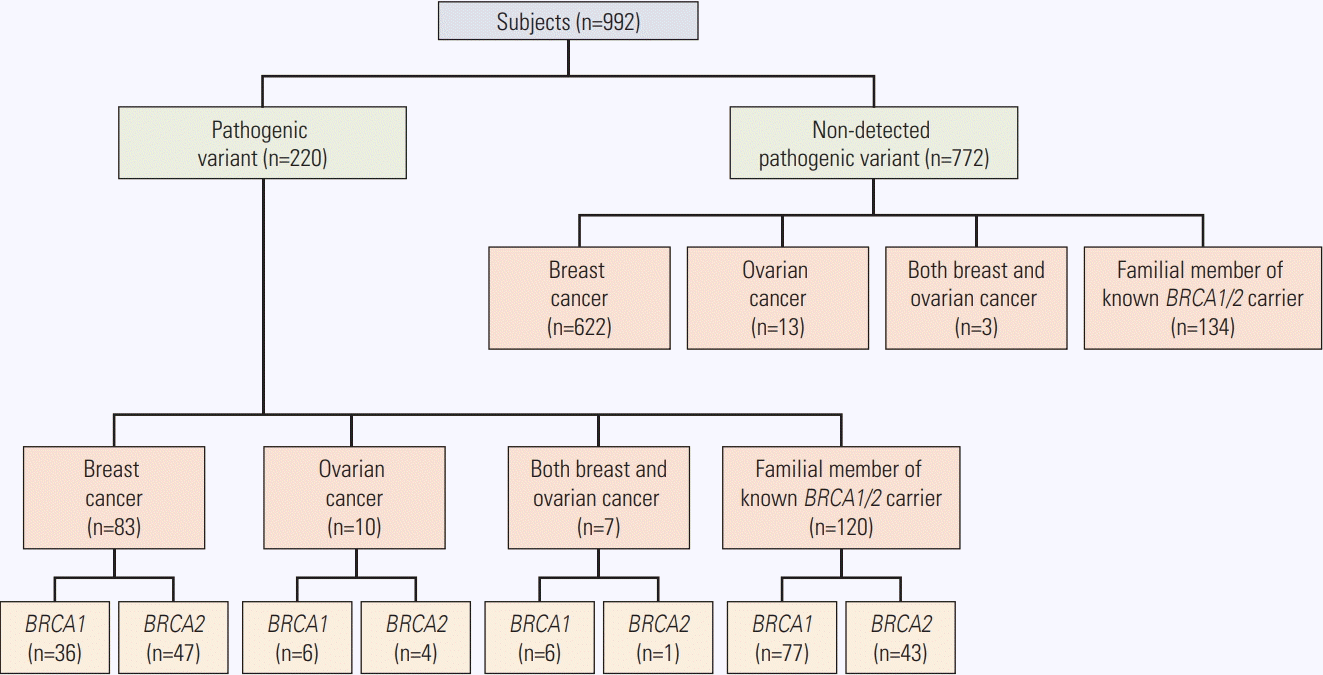1. Claus EB, Schildkraut JM, Thompson WD, Risch NJ. The genetic attributable risk of breast and ovarian cancer. Cancer. 1996; 77:2318–24.

2. Easton DF. How many more breast cancer predisposition genes are there? Breast Cancer Res. 1999; 1:14–7.

3. Beattie MS, Crawford B, Lin F, Vittinghoff E, Ziegler J. Uptake, time course, and predictors of risk-reducing surgeries in BRCA carriers. Genet Test Mol Biomarkers. 2009; 13:51–6.
4. Campeau PM, Foulkes WD, Tischkowitz MD. Hereditary breast cancer: new genetic developments, new therapeutic avenues. Hum Genet. 2008; 124:31–42.

5. Pal T, Permuth-Wey J, Betts JA, Krischer JP, Fiorica J, Arango H, et al. BRCA1 and BRCA2 mutations account for a large proportion of ovarian carcinoma cases. Cancer. 2005; 104:2807–16.
6. Friedenson B. BRCA1 and BRCA2 pathways and the risk of cancers other than breast or ovarian. MedGenMed. 2005; 7:60.
7. Meijers-Heijboer H, van Geel B, van Putten WL, Henzen-Logmans SC, Seynaeve C, Menke-Pluymers MB, et al. Breast cancer after prophylactic bilateral mastectomy in women with a BRCA1 or BRCA2 mutation. N Engl J Med. 2001; 345:159–64.
8. Greene MH, Mai PL, Schwartz PE. Does bilateral salpingectomy with ovarian retention warrant consideration as a temporary bridge to risk-reducing bilateral oophorectomy in BRCA1/2 mutation carriers? Am J Obstet Gynecol. 2011; 204:19.
9. Morris JL, Gordon OK. Positive results: making the best decisions when you're at high risk for breast or ovarian cancer. Amherst, NY: Prometheus Books;2010.
10. Daly MB, Pilarski R, Axilbund JE, Berry M, Buys SS, Crawford B, et al. Genetic/familial high-risk assessment: breast and ovarian, version 2.2015. J Natl Compr Canc Netw. 2016; 14:153–62.

11. Schwartz MD, Isaacs C, Graves KD, Poggi E, Peshkin BN, Gell C, et al. Long-term outcomes of BRCA1/BRCA2 testing: risk reduction and surveillance. Cancer. 2012; 118:510–7.
12. Kim SI, Lim MC, Lee DO, Kong SY, Seo SS, Kang S, et al. Uptake of risk-reducing salpingo-oophorectomy among female BRCA mutation carriers: experience at the National Cancer Center of Korea. J Cancer Res Clin Oncol. 2016; 142:333–40.
13. Fu R, Harris EL, Helfand M, Nelson HD. Estimating risk of breast cancer in carriers of BRCA1 and BRCA2 mutations: a meta-analytic approach. Stat Med. 2007; 26:1775–87.
14. Garcia C, Wendt J, Lyon L, Jones J, Littell RD, Armstrong MA, et al. Risk management options elected by women after testing positive for a BRCA mutation. Gynecol Oncol. 2014; 132:428–33.
15. Choi MC, Lim MC, Lee M, Kim MK, Suh DH, Song YJ, et al. Practice patterns of hereditary ovarian cancer management in Korea. Int J Gynecol Cancer. 2017; 27:895–9.

16. Lim MC, Moon EK, Shin A, Jung KW, Won YJ, Seo SS, et al. Incidence of cervical, endometrial, and ovarian cancer in Korea, 1999-2010. J Gynecol Oncol. 2013; 24:298–302.

17. Watson M, Foster C, Eeles R, Eccles D, Ashley S, Davidson R, et al. Psychosocial impact of breast/ovarian (BRCA1/2) cancer-predictive genetic testing in a UK multi-centre clinical cohort. Br J Cancer. 2004; 91:1787–94.
18. Del Corral GA, Wes AM, Fischer JP, Serletti JM, Wu LC. Outcomes and cost analysis in high-risk patients undergoing simultaneous free flap breast reconstruction and gynecologic procedures. Ann Plast Surg. 2015; 75:534–8.

19. Hagen AI, Maehle L, Veda N, Vetti HH, Stormorken A, Ludvigsen T, et al. Risk reducing mastectomy, breast reconstruction and patient satisfaction in Norwegian BRCA1/2 mutation carriers. Breast. 2014; 23:38–43.
20. Hooker GW, King L, Vanhusen L, Graves K, Peshkin BN, Isaacs C, et al. Long-term satisfaction and quality of life following risk reducing surgery in
BRCA1/2 mutation carriers. Hered Cancer Clin Pract. 2014; 12:9.

21. Gamble C, Havrilesky LJ, Myers ER, Chino JP, Hollenbeck S, Plichta JK, et al. Cost effectiveness of risk-reducing mastectomy versus surveillance in BRCA mutation carriers with a history of ovarian cancer. Ann Surg Oncol. 2017; 24:3116–23.
22. Evans DG, Barwell J, Eccles DM, Collins A, Izatt L, Jacobs C, et al. The Angelina Jolie effect: how high celebrity profile can have a major impact on provision of cancer related services. Breast Cancer Res. 2014; 16:442.

23. Freedman R, Mountain H, Karina D, Schofield L. A retrospective exploration of the impact of the 'Angelina Jolie Effect' on the single state-wide familial cancer program in Perth, Western Australia. J Genet Couns. 2017; 26:52–62.

24. Evans DG, Wisely J, Clancy T, Lalloo F, Wilson M, Johnson R, et al. Longer term effects of the Angelina Jolie effect: increased risk-reducing mastectomy rates in
BRCA carriers and other high-risk women. Breast Cancer Res. 2015; 17:143.

25. Lim MC, Kim TJ, Kang S, Bae DS, Park SY, Seo SS. Embryonic natural orifice transumbilical endoscopic surgery (E-NOTES) for adnexal tumors. Surg Endosc. 2009; 23:2445–9.

26. Rebbeck TR, Kauff ND, Domchek SM. Meta-analysis of risk reduction estimates associated with risk-reducing salpingooophorectomy in BRCA1 or BRCA2 mutation carriers. J Natl Cancer Inst. 2009; 101:80–7.
27. Bando H. Issues of concern in risk assessment, genetic counseling, and genetic testing of younger breast cancer patients in Japan. Breast Cancer. 2014; 21:656–63.

28. Eitan R, Michaelson-Cohen R, Levavi H, Beller U. The counseling and management of young healthy BRCA mutation carriers. Int J Gynecol Cancer. 2009; 19:1156–9.
29. Kauff ND, Scheuer L, Robson ME, Glogowski E, Kelly B, Barakat R, et al. Insurance reimbursement for risk-reducing mastectomy and oophorectomy in women with BRCA1 or BRCA2 mutations. Genet Med. 2001; 3:422–5.
30. Guillem JG, Wood WC, Moley JF, Berchuck A, Karlan BY, Mutch DG, et al. ASCO/SSO review of current role of riskreducing surgery in common hereditary cancer syndromes. Ann Surg Oncol. 2006; 13:1296–321.






 PDF
PDF Citation
Citation Print
Print



 XML Download
XML Download